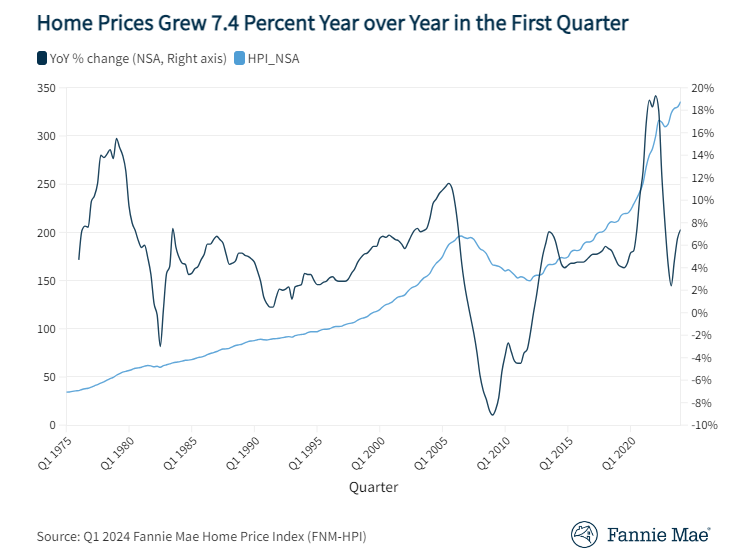Mortgage Economic Review For November 2022

A summary and review of key economic data that affects the mortgage and real estate business.
By Mark Paoletti
Mortgage Elements Inc.
The Mortgage Economic Review is a monthly summary of key economic indicators, data, and events pertinent to mortgage and real estate professionals.
AT A GLANCE: Key Economic Events and Data released during October 2022:
- Interest Rates: The 10-Year Treasury yield rose to 4.1% (Oct.. 31) from 3.83% (Sept.t. 30).
- Housing: Existing-home sales fell 1.5%, new-home sales fell 10.9%, and pending home sales fell 10.2%. Home prices fell for the second month in a row.
- Labor: The economy created 263,000 new jobs, the unemployment rate fell to 3.5%, and wages increased 5% year over year (YoY) during Sept.tember.
- Inflation: September consumer price index (CPI) rose 0.4% (+8.2% YoY); producer price index (PPI) rose 0.4% (+8.5% YoY).
- The Economy: U.S. gross domestic product (GDP) grew by a 2.6% annualized rate in the third quarter of 2022, up 1.8% YoY.
- Consumers: Retail sales was unchanged; consumer confidence declined.
- Stock markets rebounded in October: Dow +14%, S&P +8%, Nasdaq +3.9%.
- Oil prices rose to $87/barrel (Oct.. 31) from $80/barrel (Sept.t. 30). Natural gas prices fell to $5.93/MMBtu (Oct.. 31) from $6.77/MMBtu (Sept.t. 30).
Interest Rates and Fed Watch
Mortgage rates eclipsed the 7% mark for the first time in 20 years. The Fed is raising short-term interest rates to cool inflation. How high do interest rates have to go before inflation settles down? No one knows — including the Fed. So they will keep raising rates until the data indicates inflation is moderating. The trouble with inflation data is that it comes with a lag. By the time data shows lower inflation, it's already headed down. It's a moving target, and the Fed doesn't want to overshoot. Hopes on Wall Street are that the next couple of interest rate hikes will be enough to cool inflation. This means the Fed can restrain their rate hikes — most likely in 2023 — to see how Inflation responds.
- 10-Year Treasury Note yield rose to 4.1% (Oct.. 31) from 3.83% (Sept. 30).
- 30-Year Treasury Bond yield rose to 4.22% (Oct. 31) from 3.79% (Sept. 30).
- 30-Year Fixed Mortgage rose to 7.08% (Oct. 27) from 6.70% (Sept. 30).
- 15-Year Fixed Mortgage rose to 6.36% (Oct. 27) from 5.96% (Sept. 30).
- 5/1 ARM Mortgage rose to 5.96% (Oct. 27) from 5.30% (Sept. 30).
Housing Market Data Released in October 2022
“Two steps forward, one step back” is a common phrase describing how business grows and expands. Using that same euphemism for home prices, you might say, “four steps forward, one step back.” The recent decline in home prices has to be kept in context. Prices soared 20% annually for two years. Depending on the local market, home prices are up 35% — 50% since 2019. A 10% correction — even a 20% correction — still doesn't bring prices down to pre-COVID levels. In January 2020, the median existing single-family home price was $274,000; in September 2022, it hit $391,000. That's a $117,000 increase, or 42% in 20 months.
- A 10% correction from $391,000 is $39,000, bringing the median price down to $352,000 — $78,000 over the pre-COVID price of $274,000, or a 28% increase.
- A 20% correction from $391,000 is $78,000, bringing the median price down to $313,000 — $39,000 over the pre-COVID median price of $274,000, or a 14% increase.
Even with a scary 20% price drop, which is very doubtful but not inconceivable, home prices would still be up 14% in two years. That would still exceed current Inflation. Many housing analysts forecast a home price decline of 5% to 10%, depending on the local market. Demand for homes will remain strong for the next five years as more millennials form households. In the meantime, the inventory of new homes is improving. Builders are rapidly completing the construction of new homes as supply chain issues ease and building materials have become more available.
- Existing-home sales (closed deals in September) fell 1.5% to an annual rate of 4.71 million homes, down 23.8% in the last 12 months. The median price for all types of homes is $384,800 — up 8.4% from a year ago. The median single-family home price is $391,000, up 8.1% YoY. The median condo price is $331,700, up 9.8% YoY. Homes were on the market for an average of 19 days, and 70% were on the market for less than a month. Currently, 1.25 million homes are for sale; 22% of those sold were all cash sales.
- New-home sales (signed contracts in September) fell 10.9% to a seasonally adjusted annual rate of 603,000 homes — down 17.6% YoY. The median new home price rose 8% (+13.9% YoY) to $470,000. The average price fell 2.1%(+10% YoY) to $517,700. There are 462,000 new homes for sale, a 9.2-month supply.
- Pending Home Sales Index (signed contracts in September) fell 10.2% to 79.5 from 88.4 the previous month, down 31% YoY.
- Building permits (issued in September) rose 1.4% to a seasonally adjusted annual rate of 1.56 million — down 3.2% YoY. Single-family permits fell 3.1% to an annual pace of 872,000 homes, down 17.3% YoY.
- Housing starts (excavation began in September) fell 8.1% to an annual adjusted rate of 1.44 million, down 7.7% YoY. Single-family starts fell 4.7% to 892,000 units, down 18.5% YoY.
- Housing completions (completed in September) rose 6.1% to an annual adjusted rate of 1.47 million units — up 15.7% YoY. Single-family completions rose 3.2% to an annual adjusted rate of 1.05 million — up 11.1% YoY.
- S&P/Case-Shiller 20-City Home Price Index fell 1.6% in August, up 13.1% YoY.
- FHFA Home Price Index fell 0.7% in August, now up 11.9% YoY.
Labor Market Economic Data Released in October 2022
The economy created 263,000 new jobs during September, and the unemployment rate fell to 3.5%. Despite all the gloomy talk about inflation and an impending recession, the labor market has remained remarkably resilient. Labor data is showing hints of softening. Job openings were down 700,000 as employers canceled open positions, but we haven't seen significant layoffs yet. They are beginning to cut future labor costs in anticipation of a recession. Watch JOLTS (the job openings and labor turnover survey) as an excellent precursor to larger labor data.
- The economy created 263,000 new jobs in September.
- The unemployment rate fell to 3.5% in September from 3.7% in August.
- The labor force participation rate fell to 62.3% in September from 62.4% in August.
- The average hourly wage rose 0.3% in September, up 5% YoY.
- Job openings fell to 10.5 million in August from 11.2 million in July.
Inflation Economic Data Released in October 2022
Inflation remains front and center in the economic news. October inflation data has a hint of encouragement that price increases may start to cool. The big components of current inflation are the usual suspects: shelter, energy, and food prices. Shelter costs make up a third of the CPI.
When home prices decline, shelter costs also decline and apply downward pressure on the CPI. That's the good news. The bad news is that the insidious wage price spiral is rearing its ugly head. Service prices are inching up as the wage price spiral creeps into the service sector. This is significant because service sector inflation is harder to control. The longer Inflation rages on, the harder — and more painful — it will be to get it under control. Inflation in the U.S.is bad, but in Europe it’s worse — U.K. inflation rose 10.1% last month. Europeans are bracing for it to worsen as winter approaches and energy prices are expected to soar.
- CPI rose 0.4%, up 8.2% YoY | Core CPI rose 0.6%, up 6.6% YoY
- PPI rose 0.4%, up 8.5% YoY | Core PPI rose 0.3%, up 7.2% YoY
- PCE rose 0.3%, up 6.2% YoY | Core PCE rose 0.5%, up 5.1% YoY
GDP Economic Data Released in October 2022
The first estimate for third quarter GDP showed the U.S. economy grew at a 2.6% annualized rate, up 1.8% YoY. This was more than the 2.3% economists were expecting. Despite inflation, interest rates, and labor issues, the U.S. economy continues to plug along. Many economists predict a recession sometime in 2023. Even though we had two straight quarters of negative GDP, the National Bureau of Economic Research (NBER) has not called for or forecast a recession.
Consumer Economic Data Released in October 2022
Consumers continued to spend at a relatively robust pace, but there were signs of softening. Retail sales data was unchanged, but that is measured in dollar terms. "Real" retail sales were down after adjusting for inflation. Inflation is squeezing the consumer. They are directing their purchasing to more of the necessities — food, energy, shelter, and away from discretionary items. This "squeeze" is also reflected in the Consumer Confidence Index, which fell 4.9% last month.
- Retail sales were unchanged during September, up 8.2% in the last 12 months.
- Consumer Confidence Index fell 4.9% (-8.2%YoY) to 102.5 from 107.8 the prior month.
- Consumer Sentiment Index (Univ. of Mich.) rose to 59.9 from 58.6 the previous month.
Energy, International, and Things You May Have Missed
- West Texas intermediate crude rose to $87/barrel (Oct. 31) from $80/barrel (Sept. 30).
- North Sea Brent crude rose to $93/barrel (Oct. 31) from $88/barrel (Sept. 30).
- Natural gas fell to $5.93/MMBtu (Oct. 31) from $6.77/MMBtu (Sept. 30).
- The U.S. national debt was $30,928,911,613,306.73 on Sept. 30, 2022.
- OPEC cut oil production by 2 million barrels per day, angering the Biden Administration.
- Oil workers went on strike to support protests against Iran's government and its Morality Police. The Protests that started in September intensified in October.
- Ukrainian forces recaptured some of the land lost earlier to the Russians. A truck bomb (that exploded on Putin's 70th birthday) temporarily disabled the only bridge linking Crimea to Russia.
- Xi Jinping strengthened his power grip over China: He was elected to a third term as secretary general — the only other leader besides Mao Zedong to serve three terms. Plus, the seven members of the ruling Politburo Standing Committee are now all Xi loyalists.
- U.K. Prime Minister Liz Truss resigned after only 44 days in office and was replaced by former Chancellor Rishi Sunak.
- Social Security recipients will get an 8.7% cost-of-living increase in 2023 — the biggest since 1981.
- Elon Musk completed his acquisition of Twitter and immediately fired its four top execs.
The Mortgage Economic Review is produced by Mortgage Elements Inc. and MortgageElements.com, and is a concise summary of key economic data that influences the mortgage and real estate industries. The information is gathered from sources believed to be credible; some are opinion-based and editorial in nature. Mortgage Elements Inc. does not guarantee or warrant its accuracy or completeness.





